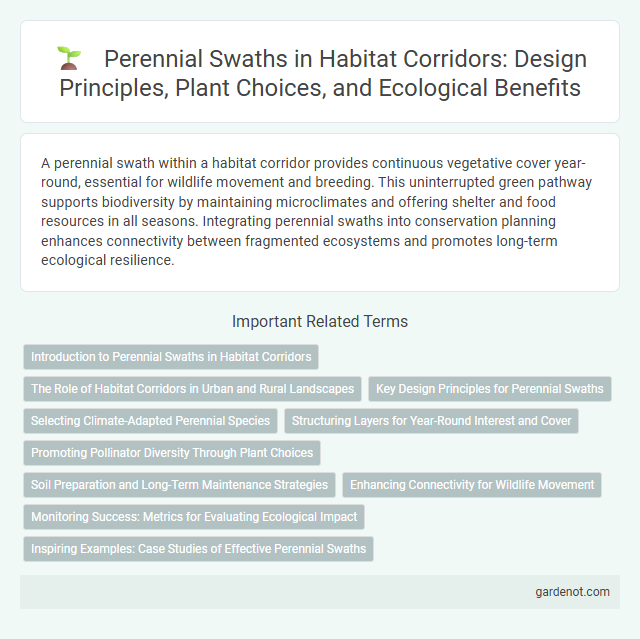A perennial swath within a habitat corridor provides continuous vegetative cover year-round, essential for wildlife movement and breeding. This uninterrupted green pathway supports biodiversity by maintaining microclimates and offering shelter and food resources in all seasons. Integrating perennial swaths into conservation planning enhances connectivity between fragmented ecosystems and promotes long-term ecological resilience.
Introduction to Perennial Swaths in Habitat Corridors
Perennial swaths in habitat corridors consist of continuous strips of long-lived vegetation that provide stable shelter and food sources for wildlife throughout the year. These corridors facilitate animal movement, genetic exchange, and ecosystem connectivity by linking fragmented habitats. Establishing perennial swaths enhances biodiversity conservation, soil stability, and resilience to environmental changes within landscape networks.
The Role of Habitat Corridors in Urban and Rural Landscapes
Habitat corridors, such as perennial swaths of vegetation, play a crucial role in connecting fragmented ecosystems within urban and rural landscapes, facilitating wildlife movement and genetic exchange. These corridors enhance biodiversity by providing continuous habitats that support native species and promote ecological resilience against environmental changes. Maintaining perennial swaths within landscape planning is essential for sustainable land use and mitigating the effects of urbanization on natural habitats.
Key Design Principles for Perennial Swaths
Perennial swaths enhance habitat connectivity by incorporating native, diverse plant species that provide year-round cover and resources for wildlife, supporting ecological resilience. Key design principles include selecting site-appropriate species, ensuring structural diversity to accommodate multiple fauna, and maintaining continuous linear corridors that facilitate species movement and genetic exchange. Proper management practices, such as periodic monitoring and controlled disturbances, help sustain the swath's habitat quality and functionality over time.
Selecting Climate-Adapted Perennial Species
Selecting climate-adapted perennial species for habitat corridors enhances ecosystem resilience by ensuring plant survival under shifting weather patterns and extreme conditions. Species such as switchgrass (Panicum virgatum) and eastern gamagrass (Tripsacum dactyloides) demonstrate high drought tolerance and carbon sequestration potential, supporting pollinators and wildlife year-round. Integrating genetically diverse, locally sourced perennials optimizes habitat connectivity and maintains ecological function across fragmented landscapes.
Structuring Layers for Year-Round Interest and Cover
Perennial swaths create multi-layered habitat corridors by combining ground cover, shrubs, and tall perennials to provide continuous shelter and foraging opportunities throughout the year. These structuring layers enhance biodiversity by supporting diverse wildlife species with seasonal needs for nesting, feeding, and protection. Incorporating evergreen and late-blooming plants ensures visual interest and functional cover during winter months, maintaining ecological connectivity in fragmented landscapes.
Promoting Pollinator Diversity Through Plant Choices
Perennial swaths play a crucial role in promoting pollinator diversity by providing continuous floral resources throughout the growing season, supporting a wide range of pollinator species such as bees, butterflies, and hummingbirds. Selecting native perennial plants like milkweed, coneflowers, and goldenrod enhances nectar and pollen availability, creating habitat corridors that sustain pollinator populations and boost ecosystem resilience. Incorporating diverse flowering periods and plant structures within these swaths maximizes habitat suitability and contributes to the conservation of threatened pollinator species.
Soil Preparation and Long-Term Maintenance Strategies
Perennial swaths require meticulous soil preparation involving deep tilling and organic amendment incorporation to enhance nutrient retention and drainage. Long-term maintenance strategies emphasize minimal soil disturbance, periodic mulching to suppress weeds, and implementation of targeted irrigation systems to sustain soil moisture and promote robust root development. Regular soil health monitoring through pH testing and microbial activity assessments ensures adaptive management practices that support diverse, resilient plant communities within the habitat corridor.
Enhancing Connectivity for Wildlife Movement
Perennial swaths act as vital habitat corridors that maintain continuous vegetation cover throughout the year, facilitating unimpeded wildlife movement and gene flow across fragmented landscapes. These corridors enhance ecological connectivity by linking isolated habitats, reducing the risks of inbreeding and local extinctions. Maintaining perennial swaths supports biodiversity conservation by enabling species migration, foraging, and seasonal dispersal critical for ecosystem resilience.
Monitoring Success: Metrics for Evaluating Ecological Impact
Monitoring success of perennial swaths within habitat corridors involves assessing biodiversity indices, species movement frequency, and plant community health over time. Key metrics include population density changes of indicator species, genetic flow rates across fragmented landscapes, and soil quality parameters reflecting habitat restoration. Regular field surveys paired with remote sensing technology enable precise evaluation of ecological impact and corridor functionality.
Inspiring Examples: Case Studies of Effective Perennial Swaths
Perennial swaths serve as vital habitat corridors by supporting biodiversity and enabling wildlife movement across fragmented landscapes. Effective case studies include the Tallgrass Prairie Trail in Illinois, where native perennial grasses enhance ecosystem connectivity and improve soil health. In California, the Sonoma Creek perennial swath demonstrates how multi-species plantings create resilient corridors that sustain pollinators and small mammals.
Perennial swath Infographic

 gardenot.com
gardenot.com